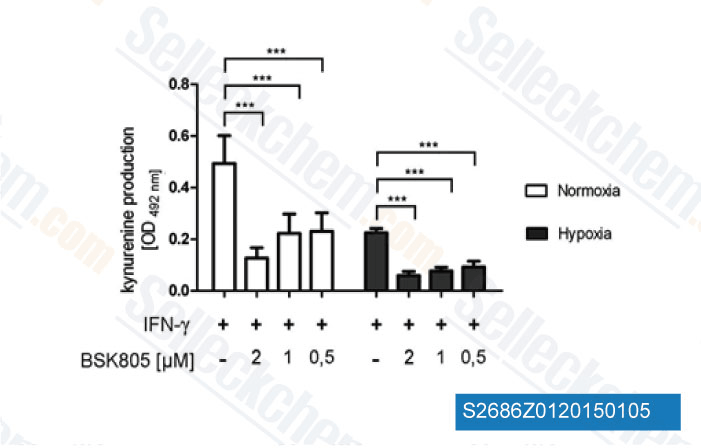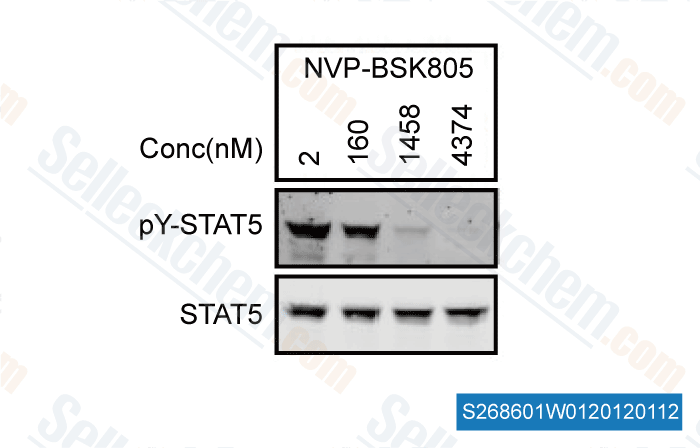|
Toll Free: (877) 796-6397 -- USA and Canada only -- |
Fax: +1-832-582-8590 Orders: +1-832-582-8158 |
Tech Support: +1-832-582-8158 Ext:3 Please provide your Order Number in the email. |
Technical Data
| Formula | C27H28F2N6O.2HCl |
||||||
| Molecular Weight | 563.47 | CAS No. | 1942919-79-0 | ||||
| Solubility (25°C)* | In vitro | DMSO | 100 mg/mL (177.47 mM) | ||||
| Water | 100 mg/mL (177.47 mM) | ||||||
| Ethanol | 6 mg/mL (10.64 mM) | ||||||
| In vivo (Add solvents to the product individually and in order) |
|
||||||
|
* <1 mg/ml means slightly soluble or insoluble. * Please note that Selleck tests the solubility of all compounds in-house, and the actual solubility may differ slightly from published values. This is normal and is due to slight batch-to-batch variations. * Room temperature shipping (Stability testing shows this product can be shipped without any cooling measures.) |
|||||||
Preparing Stock Solutions
Biological Activity
| Description | NVP-BSK805 2HCl is a potent and selective ATP-competitive JAK2 inhibitor with IC50 of 0.5 nM,>20-fold selectivity towards JAK1, JAK3 and TYK2. | ||||||||
|---|---|---|---|---|---|---|---|---|---|
| Targets |
|
||||||||
| In vitro | NVP-BSK805 is found to potently inhibit JAK2, whereas displaying more than 20-fold selectivity towards JAK1, JAK3, and TYK2. NVP-BSK805 causes half-maximal inhibition of full-length JAK2V617F and JAK2 wild-type enzymes at 0.5 nM. NVP-BSK805 blocks the growth of JAK2V617F cells (Ba/F3) and induces apoptosis with a GI50 at concentrations <100 nM. As constitutive STAT5 phosphorylation in dependent on JAK2, NVP-BSK805 is found to potently suppress STAT5 phophorylation at ≥ 100 nM concentrations in the JAK2 V617F -mutant cell lines, like MB-02. Incubation of SET-2 cells with 150 nM and 1µM of NVP-BSK805, which corresponds to concentration yielding 75% and 95% growth inhibition, respectively, for 24, 48, and 72 hours lead to concentration- and time- dependent induction of apoptosis. These results are evidenced by the detection of cleaved PARP, reduced Bcl-xL expression, and a strong increase in the number of cells with less than 2N DNA content. [1] NVP-BSK805 triggered cell death requires activation of caspase cascades and is overcome by caspase inhibition in both SET-2 and MB-02 cells. NVP-BSK805 modulates the post-translational modification of Bim and levels of Mcl-1 in JAK2V617F cells, SET-2 and MB-02 cells. [2] | ||||||||
| In vivo | Oral bioavailability of NVP-BSK805 in mice is estimated to be 45%, while it is 50% in rats. Oral administration of NVP-BSK805 at 150 mg/kg suppresses STAT5 phosphorylation, splenomegaly, and leukemic cell spreading in a Ba/F3 JAK2V617F cell–driven mouse model. NVP-BSK805 suppresses rhEpo-induced STAT5 phosphorylation as well as rhEpo-mediated polycythemia and splenomegaly in BALB/c mice at doses of 25, 50, and 100 mg/kg orally. [1] |
Protocol (from reference)
| Kinase Assay:[1] |
|
|---|---|
| Cell Assay:[1] |
|
| Animal Study:[1] |
|
References
|
Customer Product Validation

-
Data from [Data independently produced by PLoS One, 2013, 8(5), e63301]

-
, , Dr. Catherine Rolvering and Dr. Claude Haan of Université du Luxembour

-
Data from [Data independently produced by , , J Biol Chem, 2015, 290(39):23553-62]
Selleck's NVP-BSK805 2HCl has been cited by 14 publications
| JAK2 Inhibitor, Fedratinib, Inhibits P-gp Activity and Co-Treatment Induces Cytotoxicity in Antimitotic Drug-Treated P-gp Overexpressing Resistant KBV20C Cancer Cells [ Int J Mol Sci, 2022, 23(9)4597] | PubMed: 35562984 |
| Establishment and characterization of immortalized sweat gland myoepithelial cells [ Sci Rep, 2022, 12(1):7] | PubMed: 34997030 |
| Interleukin 6 trans-signaling is a critical driver of lung allograft fibrosis [ Am J Transplant, 2021, 21(7):2360-2371] | PubMed: 33249747 |
| CXCL10/CXCR3 signaling contributes to an inflammatory microenvironment and its blockade enhances progression of murine pancreatic precancerous lesions [ Elife, 2021, 10e60646] | PubMed: 34328416 |
| IL-6 derived from therapy-induced senescence facilitates the glycolytic phenotype in glioblastoma cells [ Am J Cancer Res, 2021, 11(2):458-478] | PubMed: 33575081 |
| A Single-Cell Landscape of High-Grade Serous Ovarian Cancer [ Nat Med, 2020, 10.1038/s41591-020-0926-0] | PubMed: 32572264 |
| Revisiting Aldehyde Oxidase Mediated Metabolism in Drug-like Molecules: An Improved Computational Model [ J Med Chem, 2020, 31] | PubMed: 32191458 |
| Stomatin-like Protein 2 Promotes Tumor Cell Survival by Activating the JAK2-STAT3-PIM1 Pathway, Suggesting a Novel Therapy in CRC. [ Mol Ther Oncolytics, 2020, 30;17:169-179] | PubMed: 32346607 |
| STAT3/5 Inhibitors Suppress Proliferation in Bladder Cancer and Enhance Oncolytic Adenovirus Therapy. [ Int J Mol Sci, 2020, 21(3)] | PubMed: 32046095 |
| A novel human colon signet-ring cell carcinoma organoid line: establishment, characterization and application [ Carcinogenesis, 2020, 41(7):993-1004] | PubMed: 31740922 |
RETURN POLICY
Selleck Chemical’s Unconditional Return Policy ensures a smooth online shopping experience for our customers. If you are in any way unsatisfied with your purchase, you may return any item(s) within 7 days of receiving it. In the event of product quality issues, either protocol related or product related problems, you may return any item(s) within 365 days from the original purchase date. Please follow the instructions below when returning products.
SHIPPING AND STORAGE
Selleck products are transported at room temperature. If you receive the product at room temperature, please rest assured, the Selleck Quality Inspection Department has conducted experiments to verify that the normal temperature placement of one month will not affect the biological activity of powder products. After collecting, please store the product according to the requirements described in the datasheet. Most Selleck products are stable under the recommended conditions.
NOT FOR HUMAN, VETERINARY DIAGNOSTIC OR THERAPEUTIC USE.
